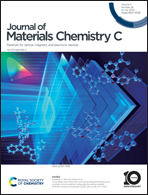Extrinsic doping of Hg2GeTe4 in the face of defect compensation and phase competition†
Abstract
Emerging semiconductors for energy and information applications increasingly consist of compounds with much higher structural and chemical complexity than their unary and binary predecessors. Often, such complexity has limited the ultimate potential of new materials due to challenges with carrier concentration control in the face of native defects. For example, native defects in ordered vacancy compound Hg2GeTe4 impose challenging requirements for extrinsic doping to achieve carrier concentration levels suitable for thermoelectric performance. Here, we address this challenge by performing first-principles defect analysis on 16 extrinsic dopants under different synthetic conditions in Hg2GeTe4. Eight of these dopants (Au, Ag, Cu, Li, In, Ga, Zn, Sc) are predicted to tune the carrier concentration over three orders of magnitude. The remaining eight dopants (Na, Mg, Y, La, Sb, Bi, Br, I) have high formation energy and are predicted to have minimal impact. Samples with the eight most promising dopants were synthesized from elemental precursors and their transport property measurements are in excellent agreement with predicted values. Consistent with theory, degenerate n-type doping proves to be unavailable, and extrinsic compensating defects are understood to be the primary barrier. The p-type dopants were found to be effective; we obtained degenerate carrier concentration with Ag and decent thermoelectric performance (zT = 0.4 at 473 K). Shifting the Fermi level to the valence band edge reduces the concentration of VHg−2 and associated ionized defect scattering. Such observations highlight the interwoven network of dependencies when doping multinary semiconductors, and emphasize the importance of theory-experimental collaborations when exploring new materials.



 Please wait while we load your content...
Please wait while we load your content...
